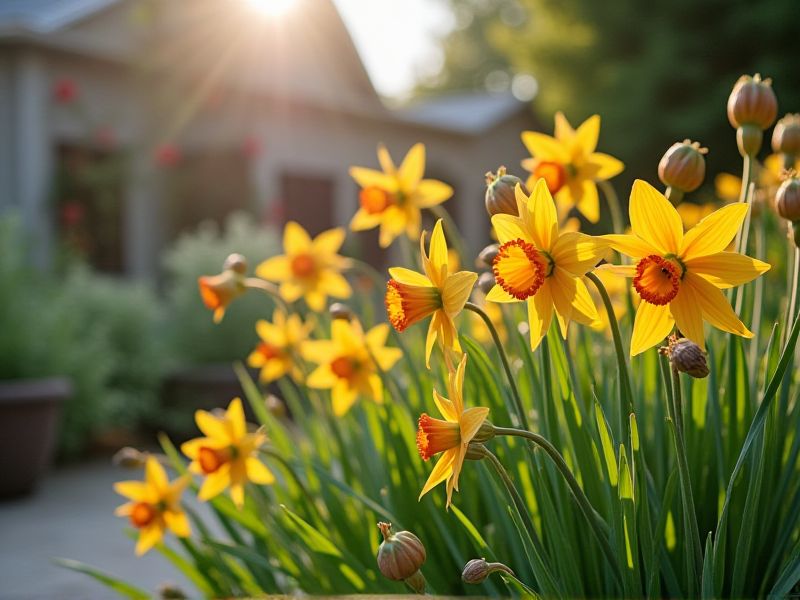
Perennial plants, such as Hellebores, Winter Jasmine, and Creeping Thyme, thrive in colder climates and can survive harsh winter conditions. These resilient species develop deep root systems that store energy, allowing them to withstand freezing temperatures and limited sunlight. Their foliage may die back during winter, but underground structures like rhizomes and tubers ensure regrowth in spring. Choosing native perennials for your garden not only enhances biodiversity but also supports local ecosystems. By selecting these hardy plants, you can enjoy vibrant blooms and lush greenery year after year.
List of some Perennial plants that survive winter
- Hosta (Hosta spp.)
- Peony (Paeonia spp.)
- Black-eyed Susan (Rudbeckia fulgida)
- Daylily (Hemerocallis spp.)
- Coneflower (Echinacea purpurea)
- Bleeding Heart (Dicentra spectabilis)
- Russian Sage (Perovskia atriplicifolia)
- Butterfly Weed (Asclepias tuberosa)
- Heuchera (Heuchera spp.)
- Sedum (Sedum spp.)
Important things about Perennial plants that survive winter
Cold Hardiness Zones
Perennial plants thrive in various cold hardiness zones, which classify regions based on minimum winter temperatures. Understanding your hardiness zone is crucial for selecting perennial species that can endure winter conditions; for instance, Zone 5 plants like Hellebores and Sedums can manage temperatures as low as -20degF. Many perennials, such as Daylilies and Coneflowers, not only survive but also bloom year after year, enriching your garden landscape. Proper mulching and site selection can enhance the survival rate of these hardy perennials, ensuring vibrant growth in the spring.
Dormancy Process
Perennial plants undergo a dormancy process to survive harsh winter conditions, where they significantly reduce metabolic activity. This adaptation allows them to conserve energy and water while protecting vital tissues from freezing temperatures. During dormancy, many perennials enter a state of altered physiological processes, often losing their leaves and storing nutrients in their roots. As temperatures warm in spring, these plants can re-emerge, utilizing their stored resources to resume growth and flowering robustly.
Root System Resilience
Perennial plants, characterized by their ability to thrive year after year, develop extensive root systems that contribute significantly to their winter survival. These roots store essential nutrients and water, allowing the plant to access resources beneath the frost line and endure harsh conditions. A well-established root system enhances the plant's resilience by providing stability and facilitating rapid growth when temperatures rise. Species such as coneflower and daylily exemplify effective root adaptations, showcasing their capacity to withstand cold temperatures and resume their life cycle with vigor come spring.
Mulching Benefits
Mulching is a crucial practice for perennial plants that thrive in winter climates, providing vital insulation against freezing temperatures. A layer of organic mulch, such as shredded leaves or straw, helps retain soil moisture while regulating soil temperature, promoting healthy root development. This protective barrier also suppresses weed growth, ensuring that your perennials have less competition for nutrients. By maintaining mulch around your plants, you enhance their chances of surviving harsh winter conditions and ensure a vibrant spring revival.
Species Selection
Perennial plants, such as Hellebores, Sedums, and Daylilies, are renowned for their resilience in surviving harsh winter conditions. These plants, characterized by their ability to return each spring, store energy in their roots, enabling them to withstand freezing temperatures. Hardy varieties like Coneflowers and Black-Eyed Susans not only survive but also flourish with minimal care, making them ideal for gardeners seeking low-maintenance options. Incorporating these perennials into your landscape can create vibrant, year-round interest while ensuring sustainable growth even through the coldest months.
Microclimates
Perennial plants thrive in microclimates, allowing them to survive winter's harsh conditions. These resilient plants, such as hellebores, sedums, and evergreens, often benefit from localized temperature variations created by structures or natural features in your garden. For instance, south-facing walls can trap heat, providing a warm refuge for delicate perennials during cold spells. By understanding your garden's microclimate, you can select and cultivate hardy perennials that will flourish year after year.
Watering Needs Before Winter
Proper watering before winter is crucial for perennial plants that survive freezing temperatures. As these plants prepare for dormancy, you should ensure they receive adequate moisture to establish robust root systems. Watering deeply but infrequently helps promote drought-resilient structures, reducing the risk of winter damage. Aim to hydrate your perennials a few weeks before the ground freezes, focusing on plants like daylilies, hostas, and sedums, which thrive in colder climates.
Pruning Techniques
Pruning perennial plants is essential for their health and vitality, especially before winter dormancy. Techniques such as deadheading, shaping, and selective cutting can encourage fuller growth and promote blooming in the following season. For winter survivors like lavender and daylilies, cutting back to healthy buds ensures the plant conserves energy and prevents disease. Use sharp, sterile tools to make precise cuts, minimizing stress and maximizing your plant's resilience to harsh winter conditions.
Pest And Disease Management
Perennial plants that endure winter conditions often face threats from pests and diseases, necessitating effective management strategies. Regular monitoring of your garden can help identify common pests like aphids or powdery mildew, which can compromise plant health during the colder months. Implementing organic solutions, such as neem oil or insecticidal soaps, can effectively control these issues without harming beneficial insects. Ensuring proper spacing and air circulation around your perennials also minimizes humidity and fosters resilience against diseases, contributing to their survival through winter.
Spring Preparation Tips
Preparing your garden for spring involves ensuring that your perennial plants are healthy and ready to thrive after winter. Start by carefully removing any dead foliage and debris around the base of the plants to promote airflow and reduce the risk of disease. Assess the soil quality, as perennials often benefit from a nutrient boost; consider adding compost or well-rotted manure to improve fertility. Finally, divide overcrowded perennials to encourage vigorous growth, allowing you to expand your garden while rejuvenating existing plants for a vibrant display.
